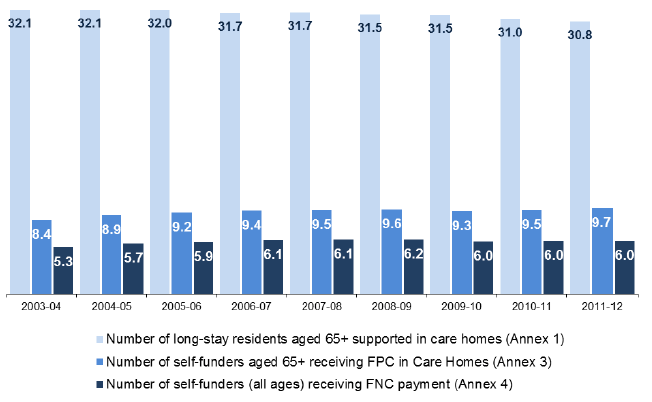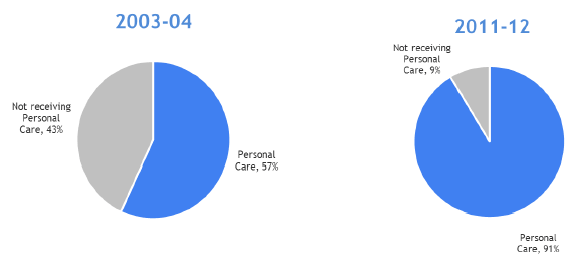Free personal and nursing care, Scotland, 2011-12
Presents the latest figures for free personal care FPC) and free nursing care (FNC).
3. People receiving Free Personal Care and Free Nursing Care
This section presents the latest available data on people receiving free personal care and nursing care in a care home and people receiving free personal care at home.
3.1 Care Homes
Since 2002, information has been collected on the number of residents aged 65+ supported by local authorities in care homes. These residents may be mainly funded by their local authority or may be a self-funder receiving the appropriate weekly payment towards their care homes fees. All of these residents receive personal care services for free.
Figure 3: Care Home residents (thousands)

Table 1: Care Home residents, 2003-04 to 2011-12
| 2003-04 | 2004-05 | 2005-06 | 2006-07 | 2007-08 | 2008-09 | 2009-10 | 2010-11 | 2011-12 | |
|---|---|---|---|---|---|---|---|---|---|
| Number of long-stay residents aged 65+ (Annex 1)1 | 32,070 | 32,070 | 32,020 | 31,680 | 31,730 | 31,540 | 31,470 | 31,020 | 30,750 |
| Number of self-funders aged 65+ receiving FPC (Annex 3)1 | 8,350 | 8,900 | 9,180 | 9,370 | 9,510 | 9,570 | 9,320 | 9,480 | 9,670 |
| Number of self-funders (all ages) receiving FNC (Annex 4)1 | 5,270 | 5,690 | 5,890 | 6,060 | 6,130 | 6,180 | 5,960 | 6,000 | 6,040 |
| Self-funders aged 65+ receiving FPC as proportion of all long-stay residents | 26.0% | 27.8% | 28.7% | 29.6% | 30.0% | 30.3% | 29.6% | 30.6% | 31.4% |
| Proportion self-funders aged 65+ receiving FPC & FNC | 63.1% | 63.9% | 64.2% | 64.7% | 64.5% | 64.6% | 63.9% | 63.3% | 62.5% |
Source: Community Care Quarterly Key Monitoring return.
1All figures are yearly averages rounded to the nearest 10.
Table 1 shows that the average number of long-stay residents aged 65+ in care homes in Scotland reduced slightly since the introduction of free personal and nursing care. In 2003-04 there were 32,070 older people in care homes reducing to 30,750 in 2011-12. The provisional figures for 2012-13 are available in Annexes 1, 2, 3 & 4.
In contrast, table 1 shows that the number of self-funding residents who receive the FPC payment for free personal care has increased each year from an average of 8,350 in 2003-04 to 9,570 in 2008-09. In 2009-10 there has been a decrease in the average to 9,320. There have been increases in both 2010-11 & 2011-12 to 9,670 which is now above the figure in 2008-09 and an increase of nearly 15 per cent from 2003-04.
The trend is the same for the proportion of long-stay residents who are self-funders. The proportion increased from 26.0 per cent 2003-04 to 30.3 per cent in 2008-09 and decreased to 29.6 per cent in 2009-10. This increased to 31.4 per cent in 2011-12.
Around two-thirds of self-funding residents receive the FNC payment in addition to the FPC payment[1]. The number of self-funders receiving free nursing care has increased by 17.3 per cent from an average of 5,270 in 2003-04 to 6,180 in 2008-09. In 2009-10, there has been a decrease in the average to 5,960, over the last two years the number of clients has increased to 6,040 this is an increase of just under 16 per cent from 2003-04.
A possible reason for the decreases shown in 2009-10 is the introduction of the National Eligibility Criteria and Waiting Times for the Personal and Nursing Care of Older People[2] during 2009-10.
3.2 Home Care
Prior to 1 July 2002, people aged 65 and over could be charged for personal care services provided in their own home. Personal Care services are now free; however, they can still be charged for domestic services such as help with shopping or housework, but any charge would be subject to a financial assessment.
Table 2: Home Care clients, 2003-04 to 2011-12
| 2003-04 | 2004-05 | 2005-06 | 2006-07 | 2007-08 | 2008-09 | 2009-10 | 2010-11 | 2011-12 | |
|---|---|---|---|---|---|---|---|---|---|
| Home Care clients aged 65+ (Annex 5)1 | 57,760 | 57,880 | 57,190 | 56,700 | 55,340 | 54,720 | 53,660 | 51,730 | 51,120 |
| Home Care clients aged 65+ receiving personal care services at home (Annex 6)1 | 32,870 | 36,300 | 40,750 | 40,410 | 42,260 | 44,200 | 46,660 | 46,950 | 46,740 |
| Average weekly hours of personal care at home (Annex 7)2 | 226,000 | 242,900 | 259,600 | 272,900 | 299,400 | 333,100 | 361,700 | 371,900 | 381,700 |
| Proportion of all home care clients aged 65+ receiving personal care | 56.9% | 62.7% | 71.3% | 71.3% | 76.4% | 80.8% | 87.0% | 90.8% | 91.4% |
| Average number of hours personal care each week | 6.9 | 6.7 | 6.4 | 6.8 | 7.1 | 7.5 | 7.8 | 7.9 | 8.2 |
Source: Community Care Quarterly Key Monitoring Return for 2003-04 to 2008/09 figures, H1 Home Care return for 2009/10 to 2011/12 figures.
1All figures are rounded to the nearest 10
2All figures are average weekly hours (based on last week of each quarter) rounded to the nearest 100.
Since the introduction of free personal care, the number of older people receiving home care services in Scotland increased from 57,760 in 2003-04 to 57,880 in 2004-05. In 2005-06, the numbers fell slightly to 57,190, followed by further falls each year to 51,120 in 2011-12.
In contrast Table 2 shows for the same period the number of home care clients receiving personal care services has increased each year from 32,870 clients in 2003-04 to 46,740 in 2011-12, this is an increase of around 42 per cent.
The number of hours of personal care provided has increased substantially from a weekly average of 226,000 hours in 2003-04 to 381,700 in 2011-12, this is an increase of just under 69 per cent. The average hours provided each week has increased by over one hour from 6.9 hours in 2003-04 to 8.2 hours in 2011-12.
Figure 4: Change in proportion of all home care clients aged 65+ receiving personal care from 2003-04 to 2011-12

Over the last eight years there has been a shift away from care homes towards more care being provided in peoples own homes. At the same time there has been an increase in the proportion of clients receiving personal care services. In 2003-04, 57 per cent of clients received personal care services. This has increased to 91 per cent in 2011-12. This increase is linked to the following National indicators:
- Improve support for people with care needs
- Increase the percentage of people aged 65 and over with high levels of care needs who are cared for at home.
The Scottish Executive publishes home care statistics annually. The latest figures, for 2011/2012, are available from:
http://www.scotland.gov.uk/Topics/Statistics/Browse/Health/Publications
Contact
Email: Steven Gillespie
There is a problem
Thanks for your feedback